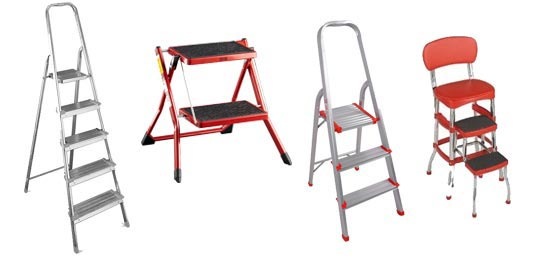Ladders are known as ancient tools of ancient technology. Ladders have been existence since at least the Mesolithic period, judging by rock paintings at the Spider Caves of Valencia, Spain (about 10,000 years ago). The picture showcases two people using a ladder to reach a wild honeybee nest for the sake of making a honey harvest. The ladder is shown as flexible and long, which means it’s probably made out of some species of grass, making it a hybrid between the rope ladder and the rigid ladder of sorts. When searching for a ladder purchase, you need to consider the material, durability, weight, and height of the product in question.

Image source: www.midlandladders.com
A step ladder is usually the first thing you picture when you hear the word ladder. A Ladder Match at a wrestling show will more likely than not feature a step ladder instead of a standard rigid ladder or an attic ladder that’s collapsible. As the most popular and common ladder type, the step ladder can be used for various jobs. The brilliance of the step ladder design comes from its ability to support itself. Rigid leaning ladders require walls to prop themselves up while step ladders can stand up on their own like a chair or a table. There’s no impetus or need to find the perfect spot for you to lean your ladder against.
Features of a Step Ladder
To reiterate, a step ladder is primarily known for its ability to be folded up and placed in small, narrow areas for storage and its excellent self-supporting legs when you fold it open so that you don’t have to prop it up against anything. It’s also lightweight and small (unless you’re buying a large and tall ladder for rooftop work). The step ladder serves as an excellent tool when it comes to dealing with low heights, such as painting the top of walls or ceilings. Step ladders can be made of wood, but most are made of fiberglass and aluminum for better mobility.

Image source: www.apartmenttherapy.com
The shorter ones can be made of tougher stainless steel, but the larger ones require lighter materials since they’re bigger, heavier, and quite cumbersome to carry when made of steel. What’s more, these ladders are typically 50 centimeters or less. The smallest step ladders are around three feet high and are comparable to step stools. The average step ladder can go from five to nine feet in height, though there are ladders that are as high as twenty feet. In other words, they can be as high as 4 to 5 meters!
They’re tough and stable plus they could fold out to create a four-legged base when it comes to dealing with areas where the ladder cannot have a wall to lean on. You can even use these ladders folded in order to double as leaning ladders if you wish. Prior to getting either a front step or twin step ladder, you should keep in mind proper usage of the item. Just because you have an eight-foot ladder on hand doesn’t mean you can stand on the ground eight feet high.
Uses of a Step Ladder
A step ladder is relatively stable and you can set it up inside or outside your home with ease. Of course, certain ladder heights can prove too big for a home if the ceiling is low. However, the sky is the (figurative) limit when it comes to ladders and outdoor use (like when attempting to climb up a particularly high tree). It’s useful when it comes to mundane things like changing the light bulb in your ceiling without having to stack books and tables on top of each other or cleaning the exterior parts of your window on a two-story house. It’s a piece of cake when you have a step ladder you could call your own!
Many professionals also make use of step ladders such as roofers, woodworkers, painters, construction workers, and any professional involved in home improvement or cleanup and upkeep. Step ladders are arguably the most stable and versatile ladder type around. You should keep ladder height in mind when picking the right product for you. These ladders come in various heights, from the three-rung ones to ten rungs or more. You should be aware of the maximum headroom of your ceiling so that you don’t end up buying a ladder that’s too big to use in your home, for instance.
Before purchasing a ladder in order to use it for all sorts of work such as accessing your roof, picking fruit, building a tree house, and cleaning out the leaves atop your storm drain, you should definitely be aware of its weight load capacity. This info is provided with the item description or user manual. Otherwise, you can contact the seller to know about it. You need to roughly know how many people the ladder can support and up to what weight can it take before it collapses. This is all for the sake of your safety and the safety of those around you, naturally.
Types of Step Ladder
Although step ladders themselves are a subset of the ladder family, they branch out into even more subcategories that vary in material, style, size, and so forth.
-
Front Step Ladder:
The front step ladder has one side that you can climb to do your work while the other side is only there for the sake of supporting you. It’s the ladder you should avail of if you wish to do solo jobs that don’t necessarily require two people working on either side of the ladder in question. It’s a lot cheaper to buy than the twin step ladder and is perfectly serviceable for projects that require the focus of just one man doing them sans assistance.
-
Twin Step Ladder:

Image source: www.nationalladder.com
This ladder type is designed to support use on both sides, so there are rungs on either side of the foldable piece of equipment. This is the ladder you should choose so that there’s at least one person per side of the tool doing their job (like for example one person is painting a wall and the other person is changing the bulb). You could also do more cooperative work like a person holding up a fixture while the other one is responsible for the wiring.
There you have it. That’s everything you need to know about step ladders. When buying one of these ladders, you should pick ones that are best suited for your job, location, and project.
